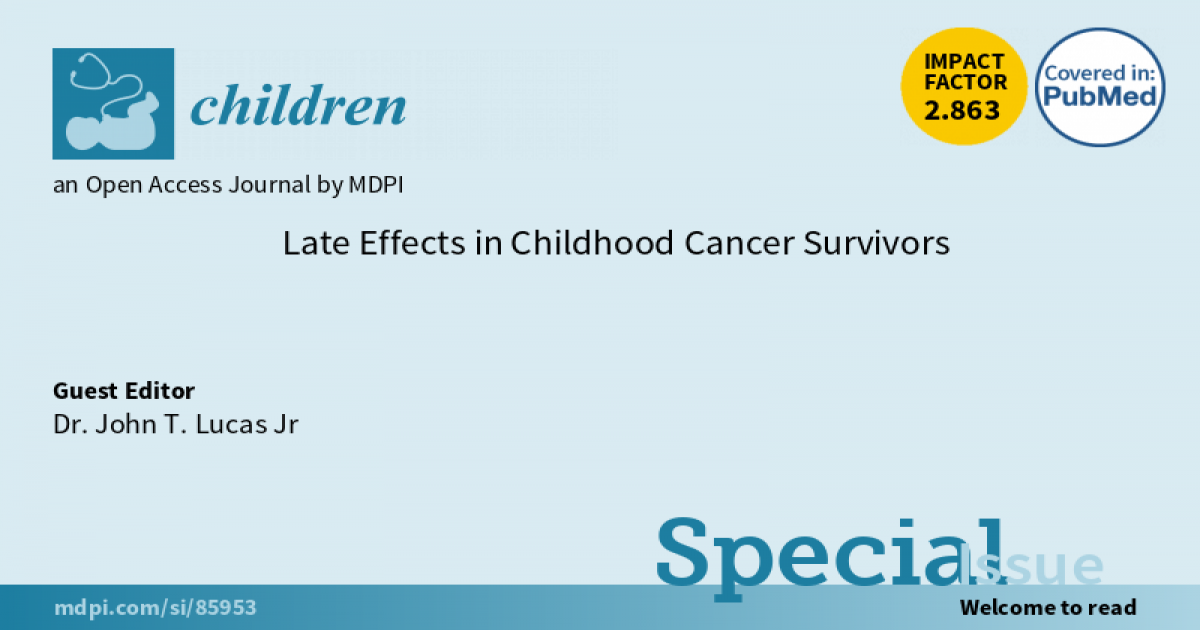Late Effects in Childhood Cancer Survivors
A special issue of Children (ISSN 2227-9067). This special issue belongs to the section "Pediatric Hematology & Oncology".
Deadline for manuscript submissions: closed (30 September 2021) | Viewed by 5610

Special Issue Editor
Interests: acute and late effects of therapy following treatment for childhood cancer; imaging as a biomarker for treatment-related injury; radiogenomics; clinical trial design/methodology; central nervous system cancer; ocular radiation oncology; pediatric radiation oncology
Special Issue Information
Dear Colleagues,
I am pleased to welcome you to contribute to this Special Issue on therapy-related morbidity in childhood cancer survivors. The literature to this point has been largely cross-sectional, although hypothesis-driven research, intervention-focused assessments, and the integration of genomics for prediction are becoming more commonplace. It is these latter areas that I would like to focus on as I believe they advance both our understanding of treatment-related late effects and improve our ability to risk stratify, treat, and manage childhood cancer survivors. Manuscripts should refer to key articles in the discipline, but then focus the discussion of the information gleaned from these historical references on how it is being used in current longitudinal studies, intervention-based trials, and basic and translational research.
I would envision >5 subject headings/topics for an in-depth review:
- Cardiovascular health
- Subsequent malignancies
- Endocrinopathies and metabolic complications
- Neurocognitive risk factors, interventions, and outcomes
- Musculoskeletal complications
We have a substantial amount of leeway on this broad topic, and as a result, I would like to invite your feedback on personal areas of special interest prior to assigning topics.
Dr. John T. Lucas Jr
Guest Editor
Manuscript Submission Information
Manuscripts should be submitted online at www.mdpi.com by registering and logging in to this website. Once you are registered, click here to go to the submission form. Manuscripts can be submitted until the deadline. All submissions that pass pre-check are peer-reviewed. Accepted papers will be published continuously in the journal (as soon as accepted) and will be listed together on the special issue website. Research articles, review articles as well as short communications are invited. For planned papers, a title and short abstract (about 250 words) can be sent to the Editorial Office for assessment.
Submitted manuscripts should not have been published previously, nor be under consideration for publication elsewhere (except conference proceedings papers). All manuscripts are thoroughly refereed through a single-blind peer-review process. A guide for authors and other relevant information for submission of manuscripts is available on the Instructions for Authors page. Children is an international peer-reviewed open access monthly journal published by MDPI.
Please visit the Instructions for Authors page before submitting a manuscript. The Article Processing Charge (APC) for publication in this open access journal is 2400 CHF (Swiss Francs). Submitted papers should be well formatted and use good English. Authors may use MDPI's English editing service prior to publication or during author revisions.
Keywords
- childhood cancer
- late effects
- imaging
- genomics
- clinical trials
Benefits of Publishing in a Special Issue
- Ease of navigation: Grouping papers by topic helps scholars navigate broad scope journals more efficiently.
- Greater discoverability: Special Issues support the reach and impact of scientific research. Articles in Special Issues are more discoverable and cited more frequently.
- Expansion of research network: Special Issues facilitate connections among authors, fostering scientific collaborations.
- External promotion: Articles in Special Issues are often promoted through the journal's social media, increasing their visibility.
- Reprint: MDPI Books provides the opportunity to republish successful Special Issues in book format, both online and in print.
Further information on MDPI's Special Issue policies can be found here.






